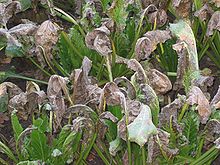
Eurotiomycetes is a large class of ascomycetes with cleistothecial ascocarps within the subphylum Pezizomycotina, currently containing around 3810 species according to the Catalogue of Life. It is the third largest lichenized class, with more than 1200 lichen species that are mostly bitunicate in the formation of asci. It contains most of the fungi previously known morphologically as "Plectomycetes".

Dothideomycetes is the largest and most diverse class of ascomycete fungi. It comprises 11 orders 90 families, 1,300 genera and over 19,000 known species. Wijayawardene et al. in 2020 added more orders to the class.

The Leotiomycetes are a class of ascomycete fungi. Many of them cause serious plant diseases.

The Botryosphaeriales are an order of sac fungi (Ascomycetes), placed under class Dothideomycetes. Some species are parasites, causing leaf spot, plant rot, die-back or cankers, but they can also be saprophytes or endophytes. They occur world-wide on many hosts. For example, in China, infections related to Botryosphaeriales have been recorded on numerous hosts such as grapes, Caragana arborescens,Cercis chinensis, Eucalyptus, Chinese hackberry, blueberry, forest trees, and various other woody hosts.

The Hysteriaceae are a taxonomic family of fungi and the only extant family of the order Hysteriales. Members of the Hysteriaceae are defined by the possession of a sexual structure called the hysterothecium, an elongated structure that opens by a longitudinal slit and releases sexually produced spores. The family is widely distributed, with many species found in temperate regions, and most are saprobic on wood and bark, although a few are parasitic on plants.
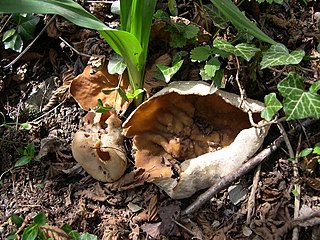
Disciotis is a genus of fungi in the family Morchellaceae. Members of this family, characterized by their cup- or bowl-shaped apothecia, have a widespread distribution, especially in northern temperate regions.

The Arthoniales is the second largest order of mainly crustose lichens, but fruticose lichens are present as well. The order contains around 1500 species, while the largest order with lichenized fungi, the Lecanorales, contains more than 14000 species.
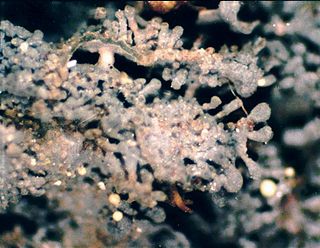
An isidium is a vegetative reproductive structure present in some lichens. Isidia are outgrowths of the thallus surface, and are corticated, usually with a columnar structure, and consisting of both fungal hyphae and algal cells. They are fragile structures and may break off and be distributed by wind, animals, and splashing raindrops. In terms of structure, isidia may be described as warty, cylindrical, clavate (club-shaped), scale-like, coralloid (coral-shaped), simple, or branched.

The Orbiliaceae are a family of saprobic sac fungi. It is the only family in the monotypic class Orbiliomycetes and the monotypic order Orbiliales. The family was first described by John Axel Nannfeldt in 1932 and now contains 288 species in 12 genera. Members of this family have a widespread distribution, but are more prevalent in temperate regions. Some species in the Orbiliaceae are carnivorous fungi, and have evolved a number of specialized mechanisms to trap nematodes.

The Inocybaceae are a family of fungi in the order Agaricales, the largest order of mushroom-forming fungi. It is one of the larger families within Agaricales. This family exhibits an ectomycorrhizal ecology. Members of this family have a widespread distribution in tropical and temperate areas.

The Coniochaetales are an order of fungi within the class Sordariomycetes. This order was monotypic and contained a single family, the Coniochaetaceae, historically placed in the order Sordariales. However, this taxonomic placement has been challenged by other authorities, and the Coniochaetales was proposed to include the family Coniochaetaceae. In 2020, family Cordanaceae was added to the order.
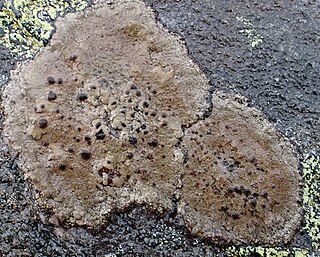
Fuscideaceae is a family of lichen-forming fungi in the order Umbilicariales. It contains five genera and about 55 species of crustose lichens.

Phacopsis is a genus of lichenicolous (lichen-dwelling) fungi. They are parasites of members of the large lichen family Parmeliaceae, of which they are also a member. Originally proposed by Edmond Tulasne in 1852 to contain 3 species, Phacopsis now contains 10 species, although historically, 33 taxa have been described in the genus. Many of the species are poorly known, some of them having been documented only from the type specimen.

The Magnaporthales are an order of fungi within the class Sordariomycetes and subclass Diaporthomycetidae. It has several water based species and genera.

Ferdinand Theissen was a German-Austrian Jesuit priest and mycologist.
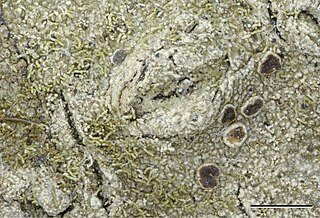
Neoprotoparmelia is a genus of crustose lichens that was created in 2018. It contains 24 tropical and subtropical species that mostly grow on bark. Neoprotoparmelia is in the subfamily Protoparmelioideae of the family Parmeliaceae, along with the morphologically similar genera Protoparmelia and Maronina.
Pachyascus is the sole genus in the family Pachyascaceae. It contains a single species, the lichen Pachyascus lapponicus. Both the genus and species were described as new to science in 1968 by lichenologists Josef Poelt and Hannes Hertel. P. lapponicus was originally collected from Lapland, a province in northern Sweden. The lichen has several unusual characteristics: it grows exclusively along with the rock moss Andreaea, it bears goniocyst-like parts and produces tiny apothecia that stand in the leaf axils of the moss, and it has thick asci.
Celotheliaceae is a family of fungi in the monotypic order Phaeomoniellales. It contains 27 species of crustose lichens with thalli that are more or less immersed in tree bark.
Pyrenidium is a genus of lichenicolous (lichen-dwelling) fungi. It is the only genus in the family Pyrenidiaceae. It has 13 species.
Obryzum is a fungal genus in the monotypic family Obryzaceae, in the class Sordariomycetes. The relationship of this taxon to other taxa within the class is unknown.
